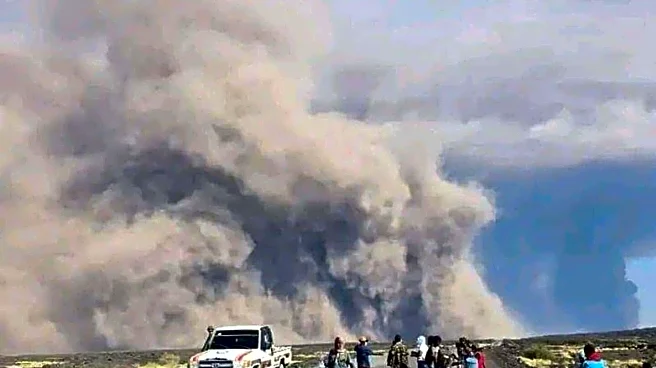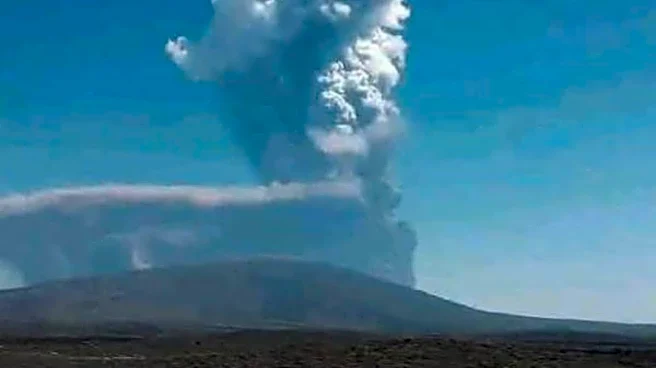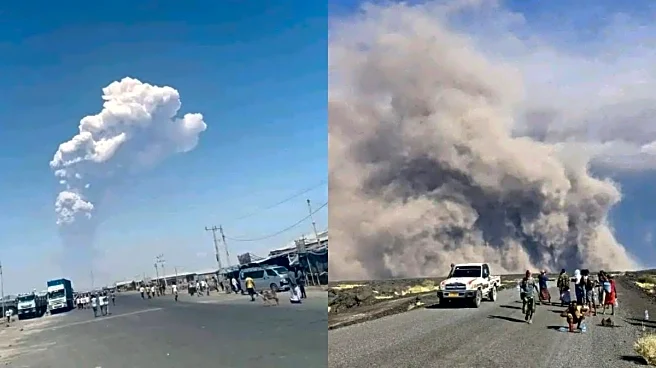What is the story about?
When the Hayli Gubbi volcano in northern Ethiopia roared back to life — its first eruption in more than 10,000 years — scientists, pilots and regulators scrambled at the same time. What began as a sudden plume of ash in the Afar region travelled hundreds of kilometres across the Red Sea, dusted nearby villages, stranded tourists, and drifted all the way into Indian airspace, forcing airlines to reroute or cancel flights.
In the village of Afdera, tucked near the Danakil desert, residents described hearing a loud boom and feeling a shock wave before ash rained over homes and grazing land. There were no reported casualties, but the fallout was immediate.
While Ethiopia dealt with ash-covered land, India’s meteorological and aviation authorities suddenly found themselves tracking a fast-moving ash plume at high altitudes.
According to Mritunjay Mohapatra, DGM, IMD, the volcanic ashes were travelling between 8.5 km and 15 km above the ground and moving at around 150 kmph.
"By Monday, the ash was already over Eastern and Central India," Mohapatra told CNBC-TV18, adding that the plume was drifting towards Delhi, Uttar Pradesh, Bihar and the Northeastern states, before it would eventually continue eastward towards China.
He stressed that the ash would leave India entirely between 7:30 pm and 8 pm on Tuesday, November 25, and that it had no impact on surface weather or air quality, but would continue to disrupt aviation services.
What actually happens during a volcanic eruption?
Despite the mythology that surrounds them, volcanoes are simply vents in the Earth’s crust where molten rock, gases and ash escape from a magma chamber below the surface.
An eruption can begin quietly, with gas-rich magma gathering near the surface, or violently, when rising magma meets groundwater or suddenly depressurises. In explosive eruptions — like Hayli Gubbi’s — trapped gases rip the magma apart and eject it as fine ash, hot fragments and towering columns of gas.
Ash from such eruptions is incredibly light, easily carried into the stratosphere, and can travel thousands of kilometres. That is exactly what Hayli Gubbi’s plume did.
Why is volcanic ash bad news for planes?
Volcanic ash is not like smoke or dust, it’s made of microscopic, jagged rock and glass. Once sucked into a jet engine, it can melt, fuse, and coat engine components, causing power loss, blockages, or, in worst-case scenarios, engine failure.
Cockpit windshields can be sandblasted to be opaque. Air-conditioning systems can pull ash into the cabin. Aircraft flying through ash clouds sometimes report the smell of smoke, reduced visibility, or engine anomalies.
To make matters worse, ash clouds often don’t appear on onboard weather radar, which means pilots rely heavily on ground advisories, satellite imagery, and pre-flight planning.
With Hayli Gubbi’s ash drifting towards India, that risk became immediate.
How it affected flights in and out of India
By Monday, the drifting ash cloud had reached Indian airspace. Citing "natural calamities linked to the volcanic eruption," Air India Express cancelled its Kochi–Jeddah service, while IndiGo scrapped its Dubai–Kochi–Dubai flights as the routes lay in the projected ash path.
In response, the DGCA issued a strict operational advisory to all Indian airlines. The regulator told carriers to:
The directive also made it mandatory to conduct post-flight engine and airframe inspections for any aircraft operating near the affected zones. Airlines were asked to restrict, suspend or modify operations to any airport lying along the ash trajectory.
What is an ASHTAM, and why did it matter here?
An ASHTAM is one of the most urgent warnings aviation authorities issue.
Unlike a regular NOTAM, which announces any change or hazard, an ASHTAM is reserved for times when volcanic ash directly threatens air operations. It includes precise coordinates, altitudes and movement forecasts of the ash cloud, information that allows airlines to draw invisible "no-fly corridors" in the sky.
With the Hayli Gubbi plume still dispersing, the DGCA has said these restrictions will remain in force until further notice.
In the village of Afdera, tucked near the Danakil desert, residents described hearing a loud boom and feeling a shock wave before ash rained over homes and grazing land. There were no reported casualties, but the fallout was immediate.
While Ethiopia dealt with ash-covered land, India’s meteorological and aviation authorities suddenly found themselves tracking a fast-moving ash plume at high altitudes.
According to Mritunjay Mohapatra, DGM, IMD, the volcanic ashes were travelling between 8.5 km and 15 km above the ground and moving at around 150 kmph.
"By Monday, the ash was already over Eastern and Central India," Mohapatra told CNBC-TV18, adding that the plume was drifting towards Delhi, Uttar Pradesh, Bihar and the Northeastern states, before it would eventually continue eastward towards China.
He stressed that the ash would leave India entirely between 7:30 pm and 8 pm on Tuesday, November 25, and that it had no impact on surface weather or air quality, but would continue to disrupt aviation services.
What actually happens during a volcanic eruption?
Despite the mythology that surrounds them, volcanoes are simply vents in the Earth’s crust where molten rock, gases and ash escape from a magma chamber below the surface.
An eruption can begin quietly, with gas-rich magma gathering near the surface, or violently, when rising magma meets groundwater or suddenly depressurises. In explosive eruptions — like Hayli Gubbi’s — trapped gases rip the magma apart and eject it as fine ash, hot fragments and towering columns of gas.
Ash from such eruptions is incredibly light, easily carried into the stratosphere, and can travel thousands of kilometres. That is exactly what Hayli Gubbi’s plume did.
Why is volcanic ash bad news for planes?
Volcanic ash is not like smoke or dust, it’s made of microscopic, jagged rock and glass. Once sucked into a jet engine, it can melt, fuse, and coat engine components, causing power loss, blockages, or, in worst-case scenarios, engine failure.
Cockpit windshields can be sandblasted to be opaque. Air-conditioning systems can pull ash into the cabin. Aircraft flying through ash clouds sometimes report the smell of smoke, reduced visibility, or engine anomalies.
To make matters worse, ash clouds often don’t appear on onboard weather radar, which means pilots rely heavily on ground advisories, satellite imagery, and pre-flight planning.
With Hayli Gubbi’s ash drifting towards India, that risk became immediate.
How it affected flights in and out of India
By Monday, the drifting ash cloud had reached Indian airspace. Citing "natural calamities linked to the volcanic eruption," Air India Express cancelled its Kochi–Jeddah service, while IndiGo scrapped its Dubai–Kochi–Dubai flights as the routes lay in the projected ash path.
In response, the DGCA issued a strict operational advisory to all Indian airlines. The regulator told carriers to:
- Avoid all designated ash-affected areas and altitudes,
- Rework flight routing, planning and fuel loads in real time,
- Rigorously follow the Operations Manual – Volcanic Ash,
- Monitor satellite data, volcanic ash advisories, NOTAMs and ASHTAMs around the clock.
The directive also made it mandatory to conduct post-flight engine and airframe inspections for any aircraft operating near the affected zones. Airlines were asked to restrict, suspend or modify operations to any airport lying along the ash trajectory.
What is an ASHTAM, and why did it matter here?
An ASHTAM is one of the most urgent warnings aviation authorities issue.
Unlike a regular NOTAM, which announces any change or hazard, an ASHTAM is reserved for times when volcanic ash directly threatens air operations. It includes precise coordinates, altitudes and movement forecasts of the ash cloud, information that allows airlines to draw invisible "no-fly corridors" in the sky.
With the Hayli Gubbi plume still dispersing, the DGCA has said these restrictions will remain in force until further notice.
/images/ppid_59c68470-image-176405254127391228.webp)




/images/ppid_a911dc6a-image-176404550095793340.webp)



/images/ppid_a911dc6a-image-176404286710753090.webp)
/images/ppid_a911dc6a-image-176404544047063153.webp)


/images/ppid_a911dc6a-image-176403763011891870.webp)


